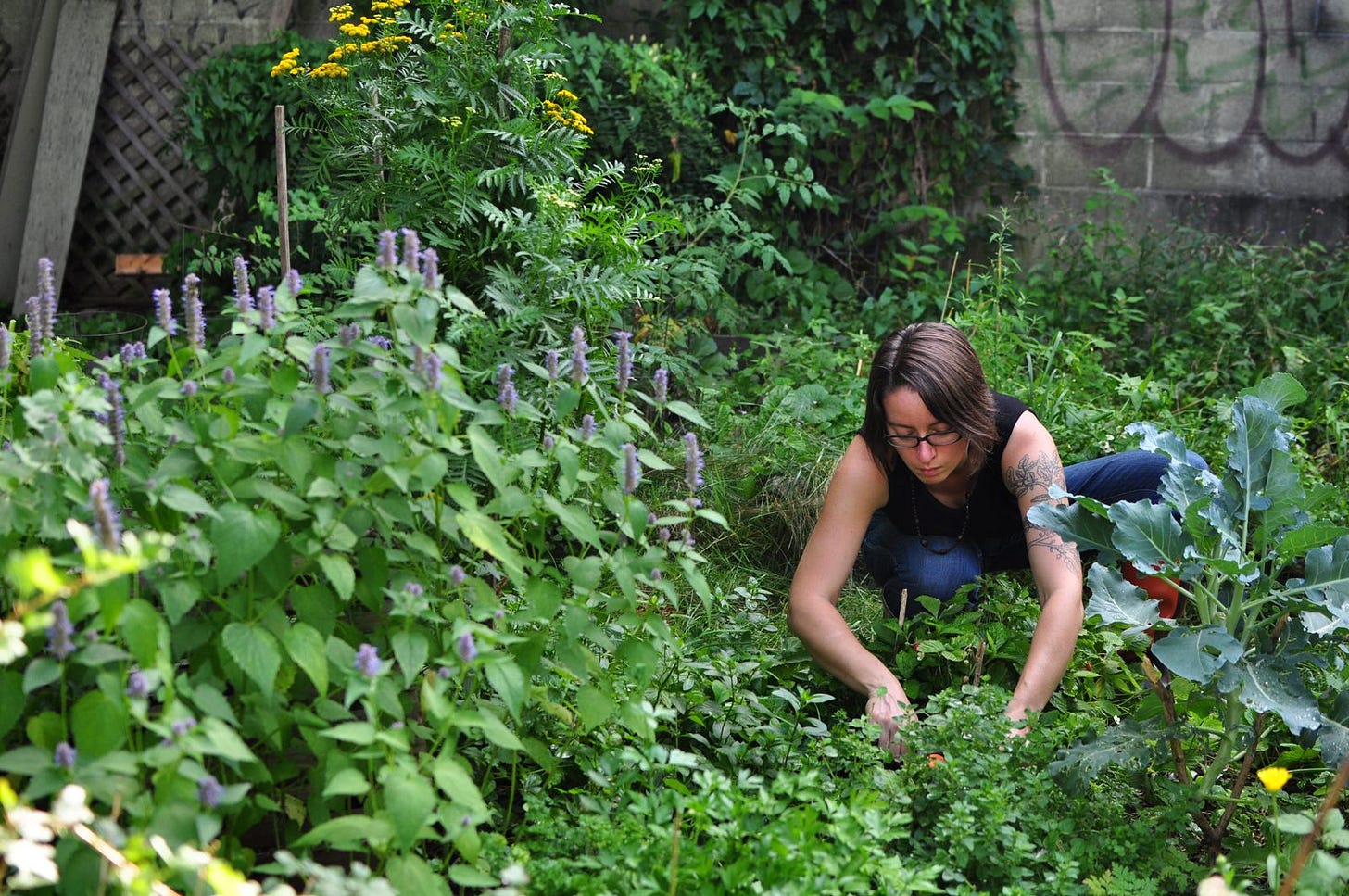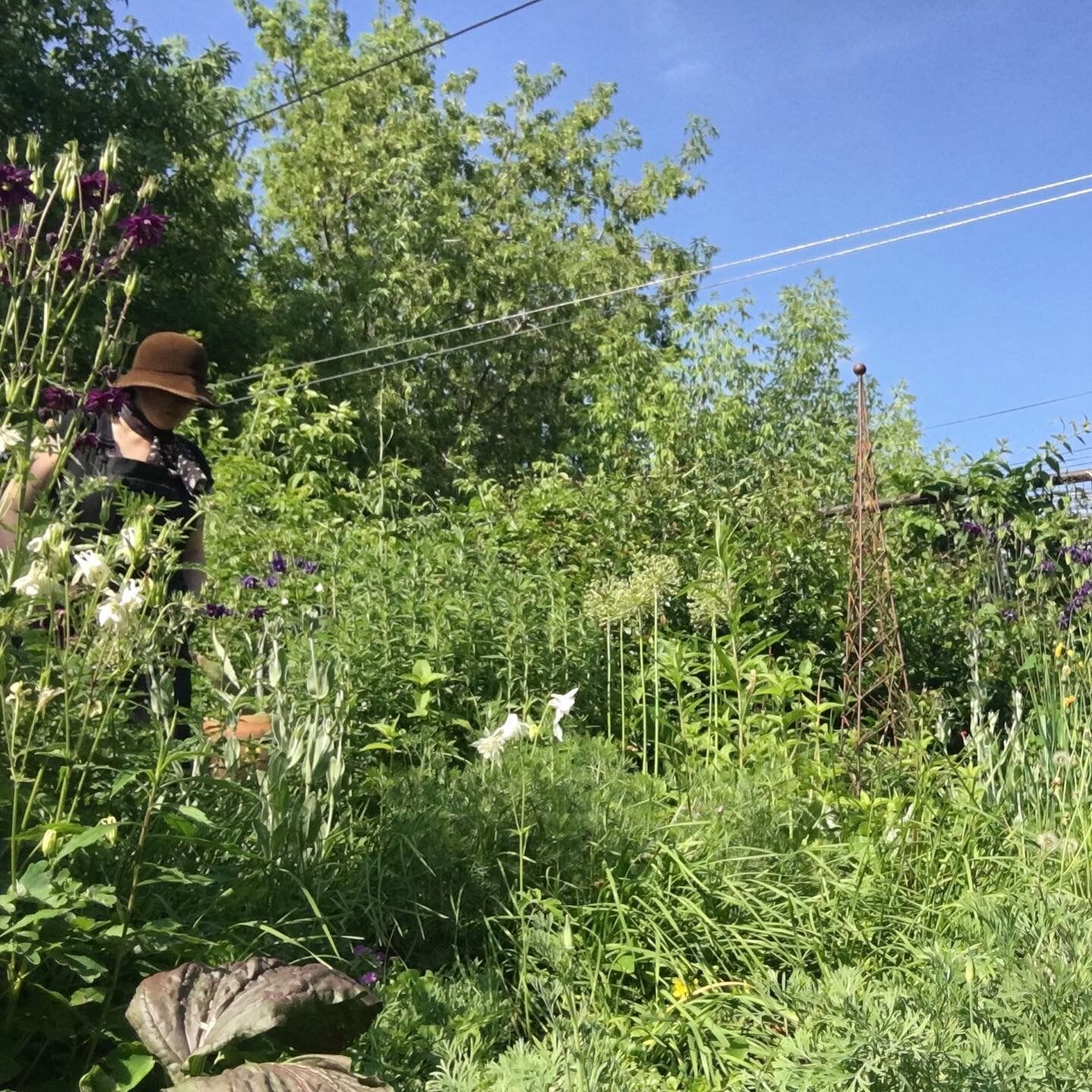This piece was written by Gayla Trail for a talk on Crip Climates: A Collaborative Syllabus for Disabled Ecologies, put together by the Architecture Foundation and which took place at the Garden Museum at the end of last month. A video of the talk in which Gayla’s words are read out is available on YouTube and she also agreed for them to be published here. You can also find more of her current long form garden writing on her Substack newsletter, Grow Curious.
Cultivating Wildness, by Gayla Trail
I became disabled 10 years ago when I contracted a very bad virus and never recovered. People with chronic illnesses like mine spend a lot of time in bed. Our beds are where we go for support to tend to our healing and our body’s need for deep rest. They are also where we eat, work, entertain, are entertained, make art, do our taxes, and have appointments with doctors, therapists, and lawyers. Our beds are a lifeline and sometimes our whole world, but they can become our prison too.
Before my life with chronic illness, I spent a lot of time outdoors in garden beds. Those beds were my grounding. As I tended to plants and earth, I also tended to the traumas of my past, and slowly remade myself into a whole person. The garden was a reprieve from the expectations, pressures, and interferences of the human world. It was where I practiced how to stay with and be the person I was becoming. It was a mirror and a compass, where I went to tend to the self, and to locate who I am between two worlds: The “civilized,” socially constructed world of humans and the wildness of the natural world. We are a part of nature, but we’ve built a way of life that is separated from nature, disconnecting us from ourselves and our kinship to every other being.
As a gardener with a body that is highly sensitive to weather patterns, I’ve thought a lot about the parallels between bodies, the Earth’s body, my body in a bed, and the beds of soil and plants in the garden.
I didn’t become a gardener with the intention to control and assert my will on the land, but in a lot of ways it was how I found myself at times, unconsciously. My way of being in the world and my relationship to nature was formed within a violent and destructive form of civilization, what social critic bell hooks named the “Imperialist, White Supremacist, Capitalist, Patriarchy.” Within it, we are conditioned to mimic colonization in our relationships, to conquer and extract rather than be in mutuality and kinship. We are groomed to become takers: from land, soil, trees, water, and even each other.
In time, the plants, insects, and other beings of the garden showed me that an untamed garden that closely resembles natural ecosystems is a healthier one and that the best gardener knows when to intervene and when to let things be. They taught me how to let go of control and respect their wildness, and as a result, I was able to find and honour the wild in me. The garden has been my classroom and also a site of rebellion, in defiance of my conditioning and a path toward another way of being that is less tamed and relational rather than hyper-individualized.
I spent years tending to gardens before I identified as a gardener, and now, decades later, I can’t imagine myself as not one. I am inextricably tied to any space or land I tend. We are connected. The bond begins to form when I touch hand to earth. My body. The earth’s body. There is no separation. Gardening is a relationship with nature and a bridge to the nature that is us. It is not just an action that I enact and perform onto an object of my creation. I create nothing. Not really. I am merely a participant and a collaborator, existing within a continuum of many.
I belong to the garden; the garden doesn’t belong to me.
Still, because a garden sits somewhere between the natural and the civilized, the gardener’s body is an essential component. During long stretches of illness, stuck in my other bed indoors, I lose contact with the beds outside that nurture me. What is a gardener who is unable to garden? I’m learning to let go of that question, knowing that everything I have given to the garden is there forever. Tending to a garden requires physicality, and before that, it requires having access to an outdoor space in which to grow. Who has access to space and the permission to alter it? These days, access often requires ownership because land is a valuable commodity and most owners want to protect their investments by keeping them orderly and “civilized.” As a disabled person my access is dependent on others because I cannot perform well enough within the Imperialist, White Supremacist, Capitalist, Patriarchy to purchase access on my own. Having learned mutuality through the garden, I was more prepared to accept the help chronic illness requires.
As the garden taught me to relinquish control, respect wildness, and find my place in what poet Mary Oliver called, “the family of things,” I have unlearned my conditioning so I can be in right relationship with myself as a wild, untamed body. In illness, the garden is showing me how to inhabit and survive in a body that is unpredictable and often teetering on the edge of vulnerability in a world that relies on predictability and abhors perceived weakness. Bodies like mine have something to teach all of us about how to create a more resilient, untamed, and relational human world so that we might survive and perhaps even turn the tide on the increasingly erratic and unpredictable road ahead as climate collapse accelerates.
I can’t speak on anything I have mentioned here without acknowledging that the land I inhabit and tend to is the traditional territories of the Haudenosaunee and Anishnabe peoples whose culture is embedded within concepts of kinship and mutuality. All gratitude to the original stewards of this region, who continue to suffer under the violence of colonialism in so called Canada.
Gayla Trail is a writer and artist with an education in the fine arts, cultural criticism, and ecology. She started writing about urban gardening 25 years ago at YouGrowGirl.com and is the author, photographer, and designer of several books on urban gardening and food growing. She is currently working to restore a half-acre plot located within Canada’s thin strip of Carolinian Life Zone that follows the Lake Erie shoreline.
Photo credits: Gayla Trail






